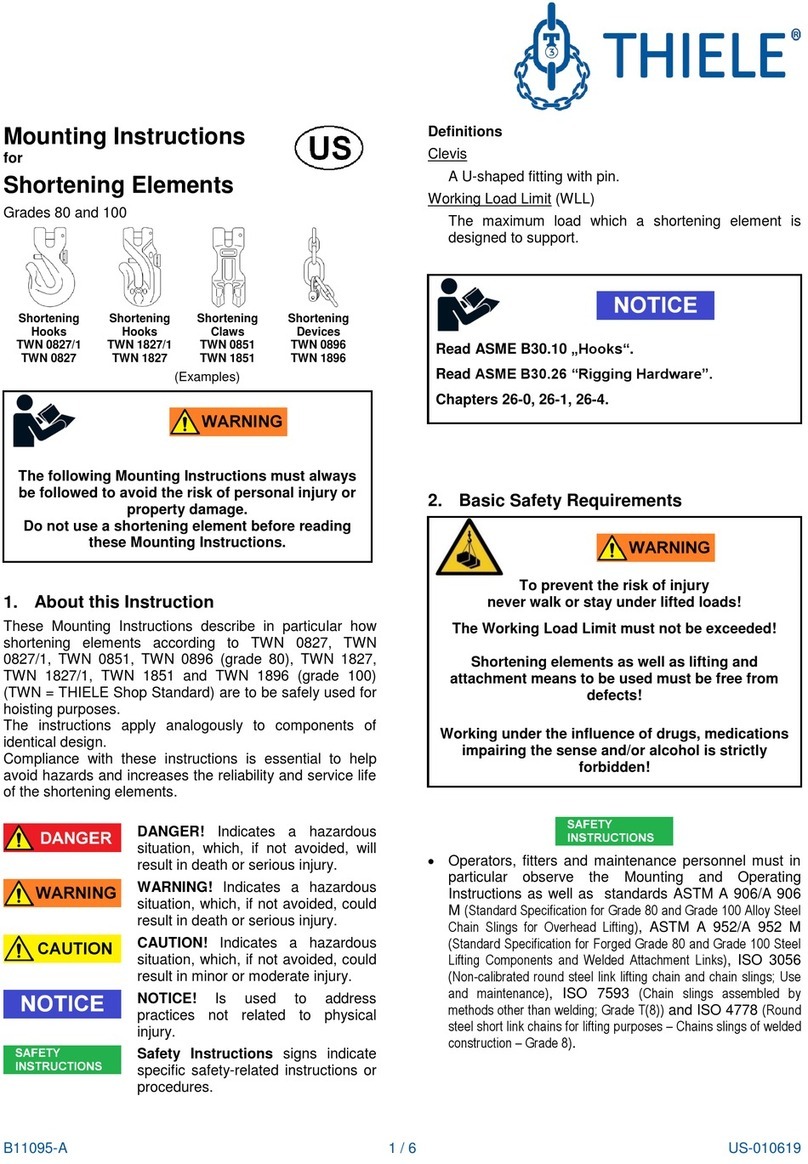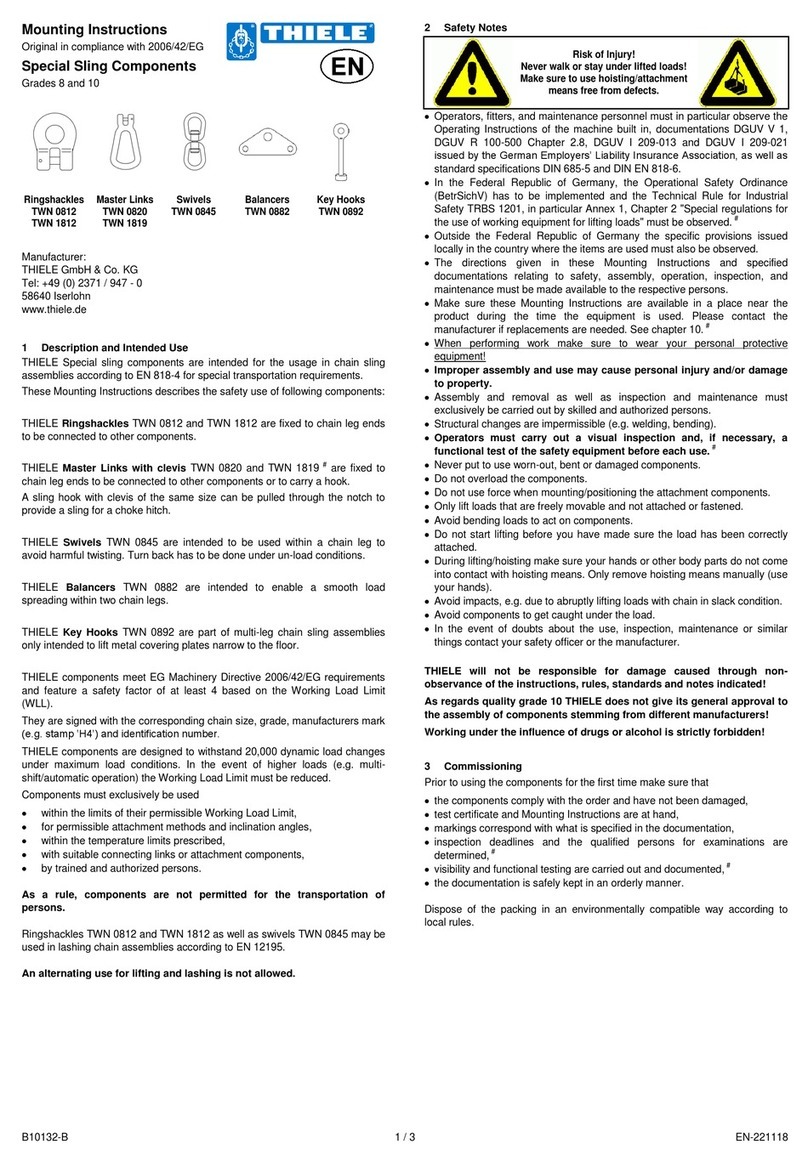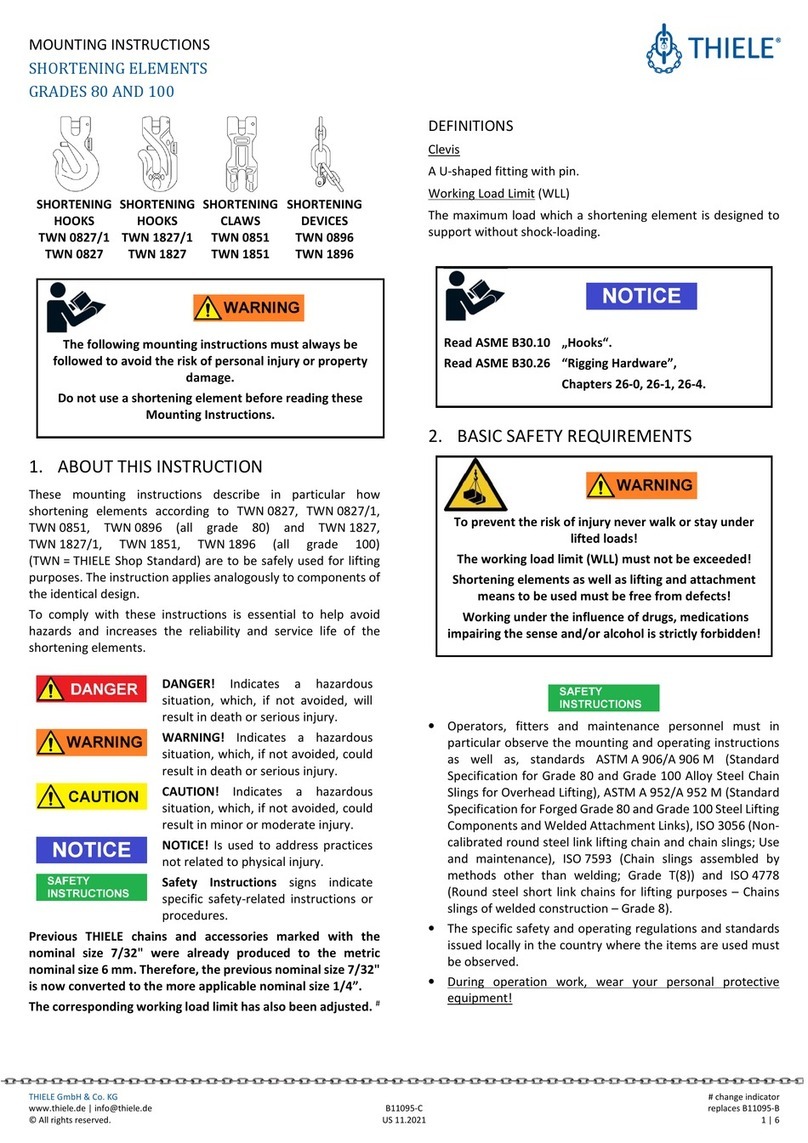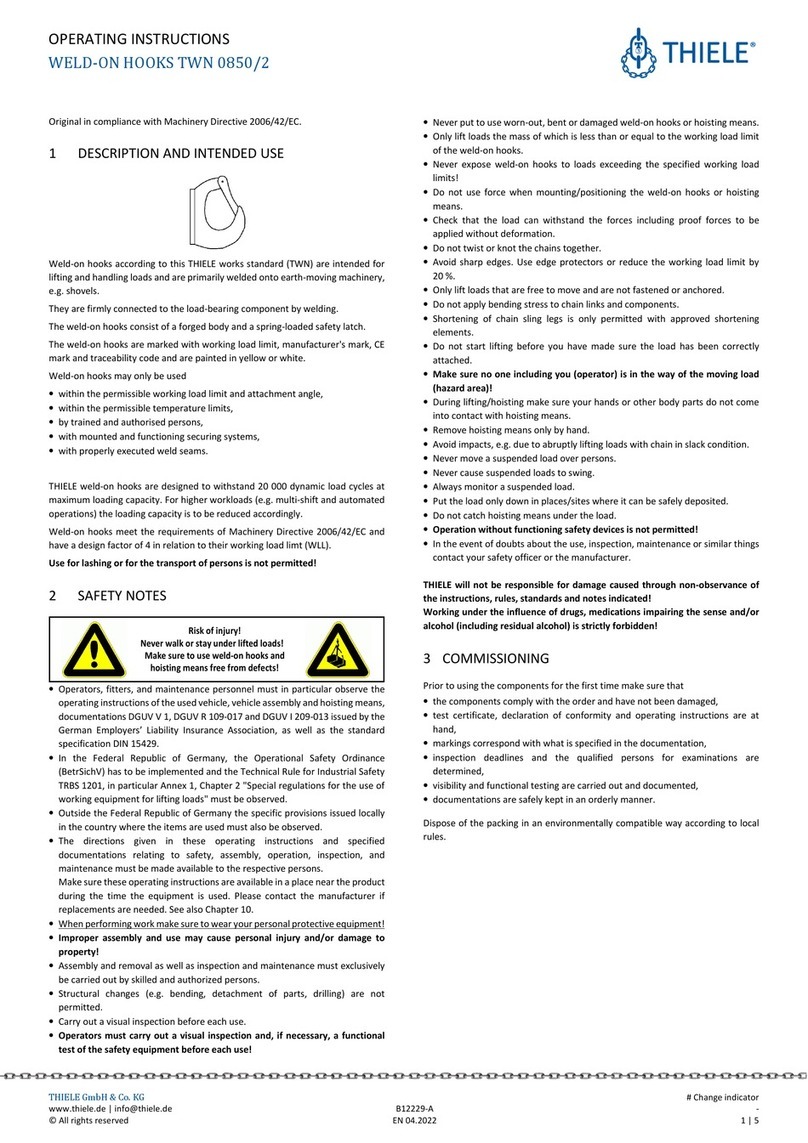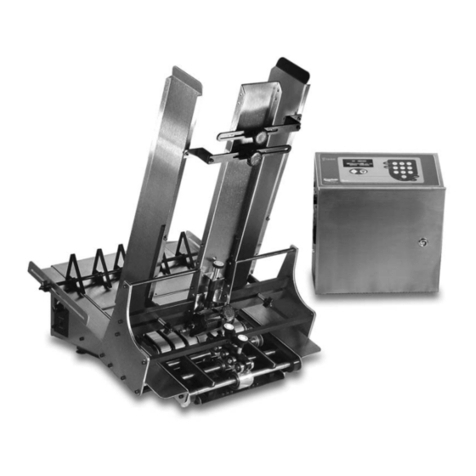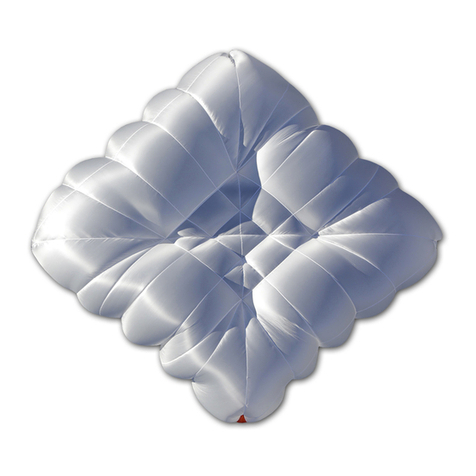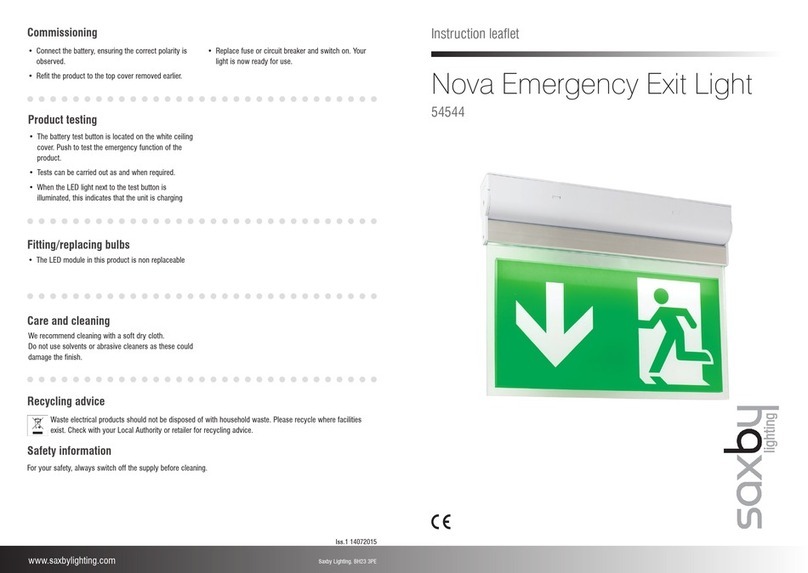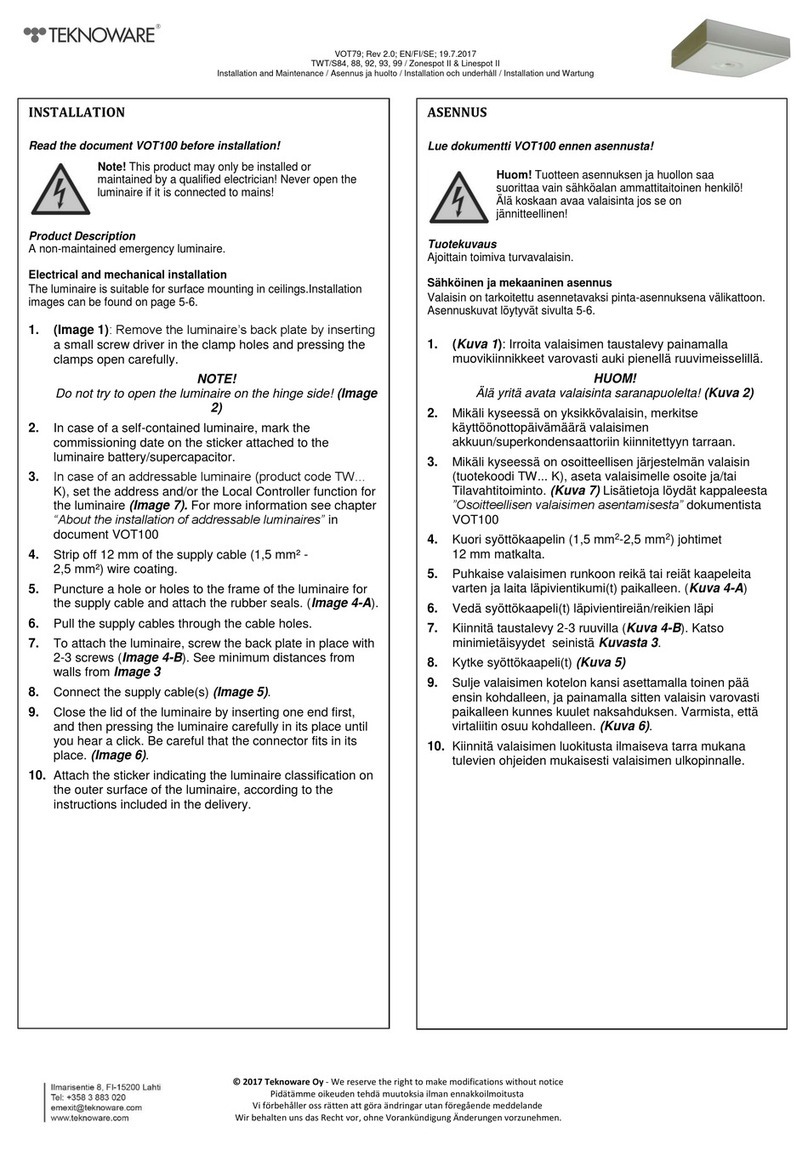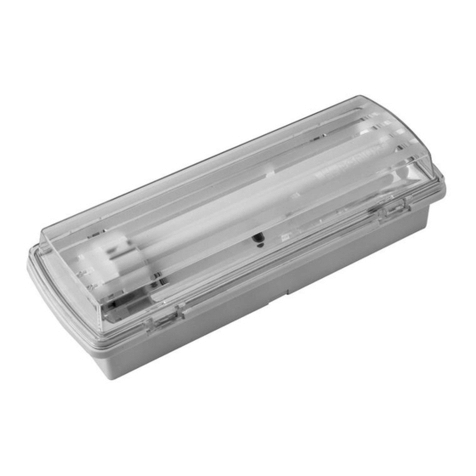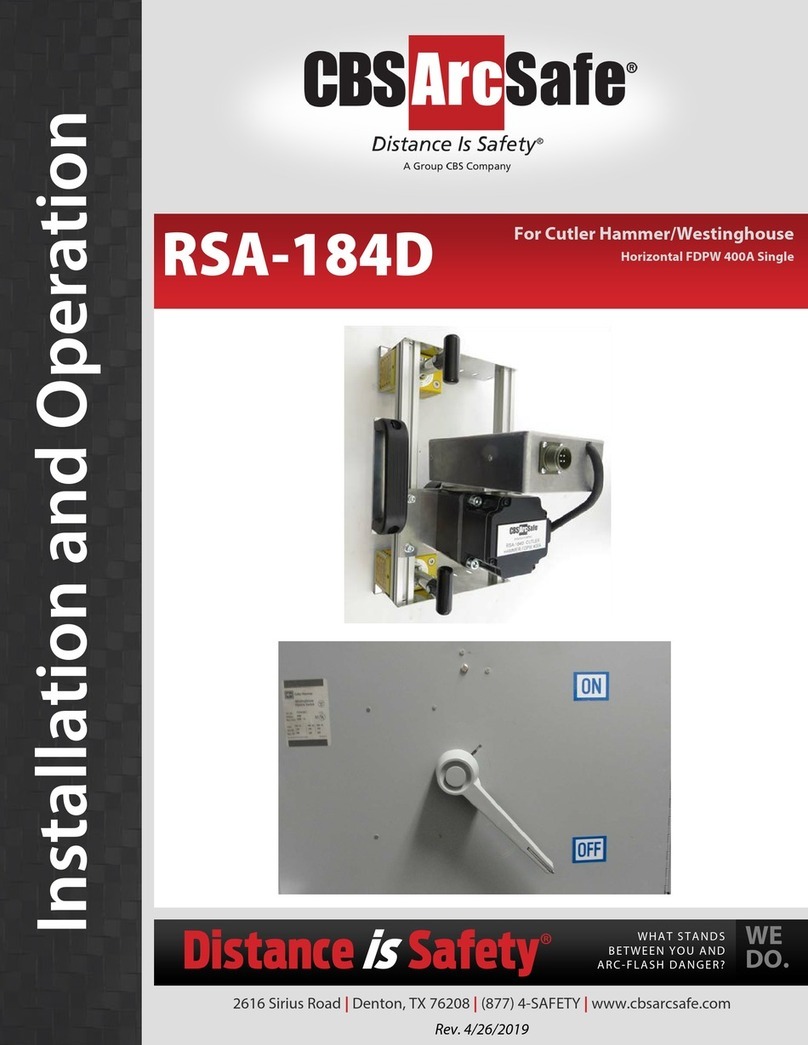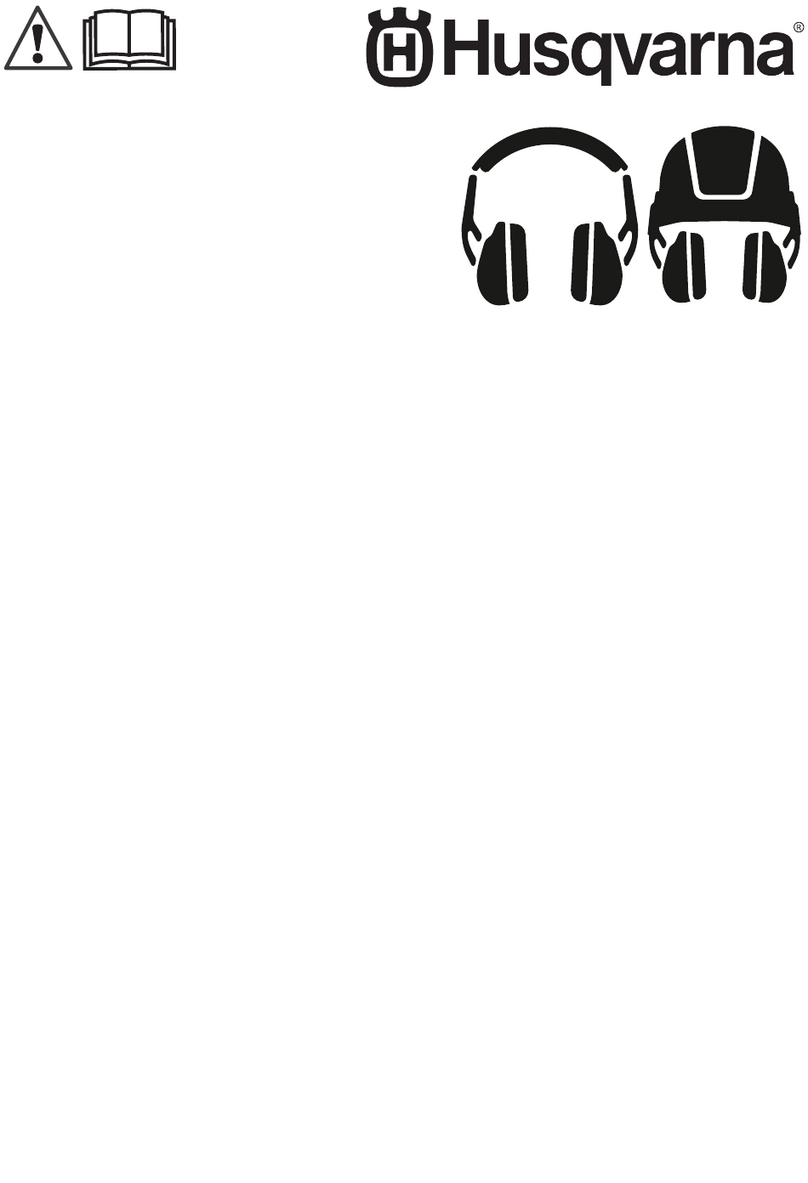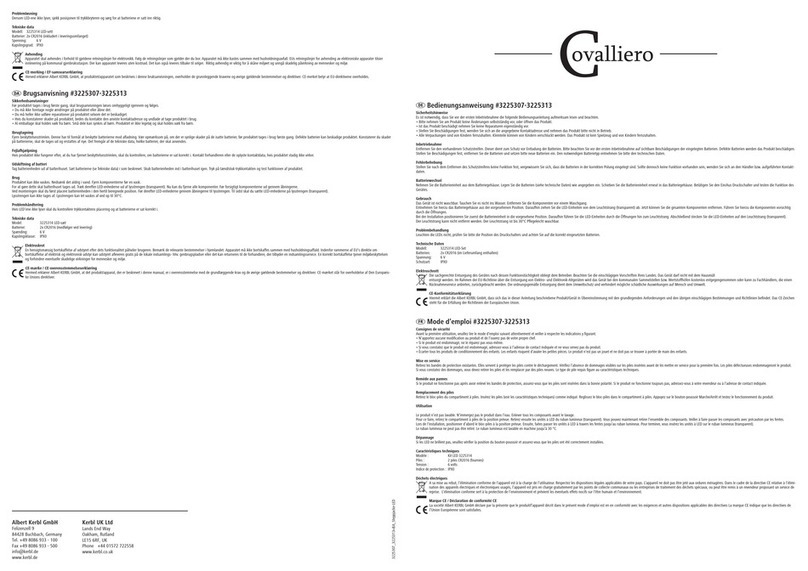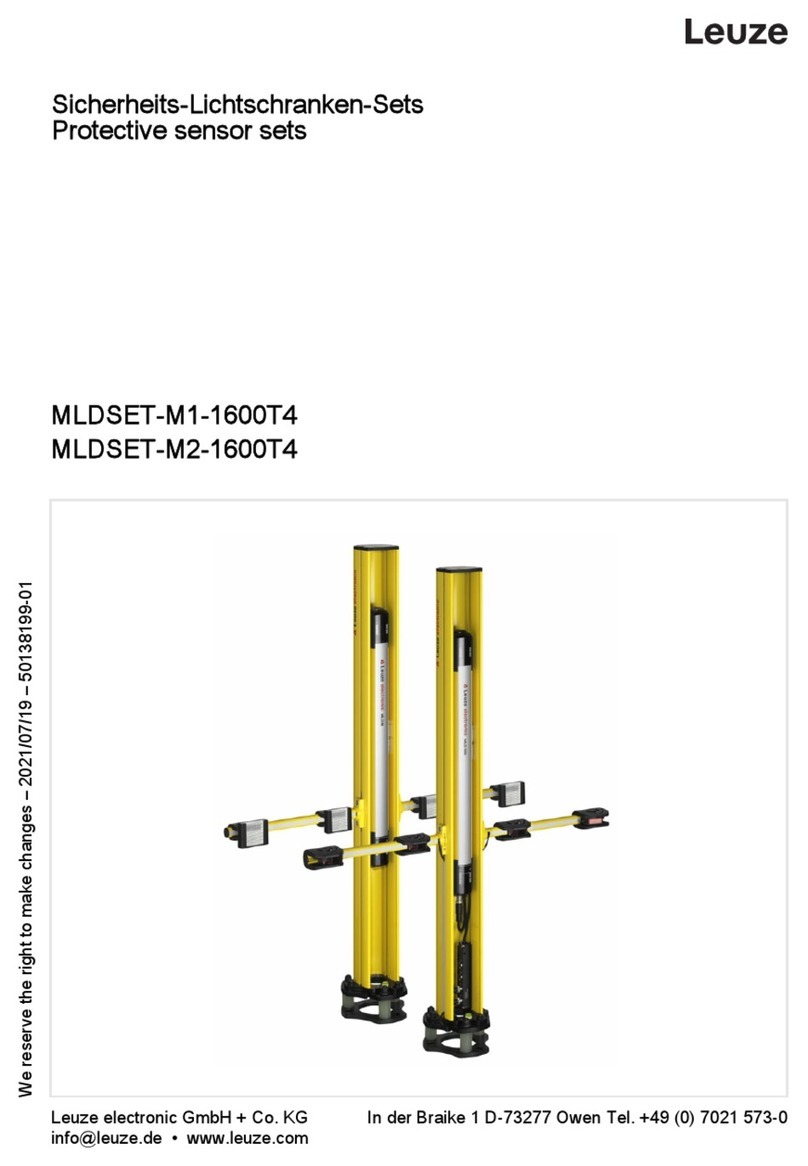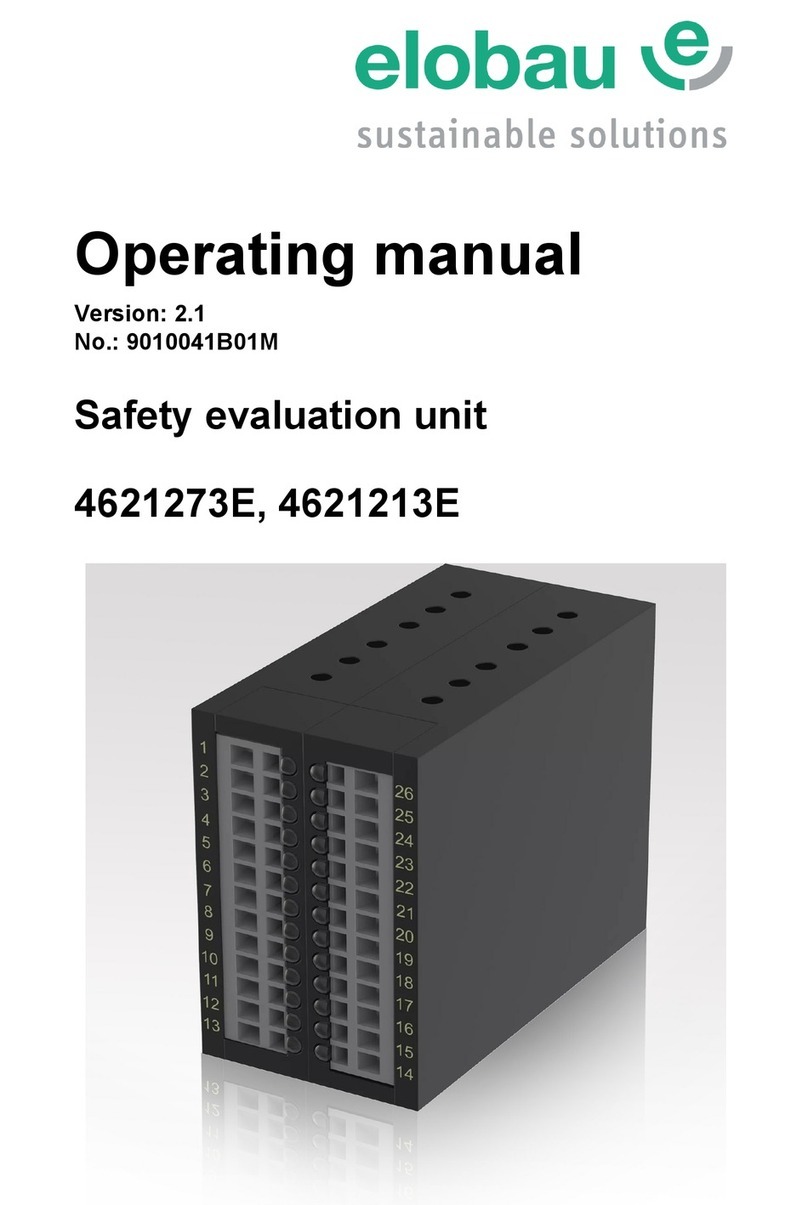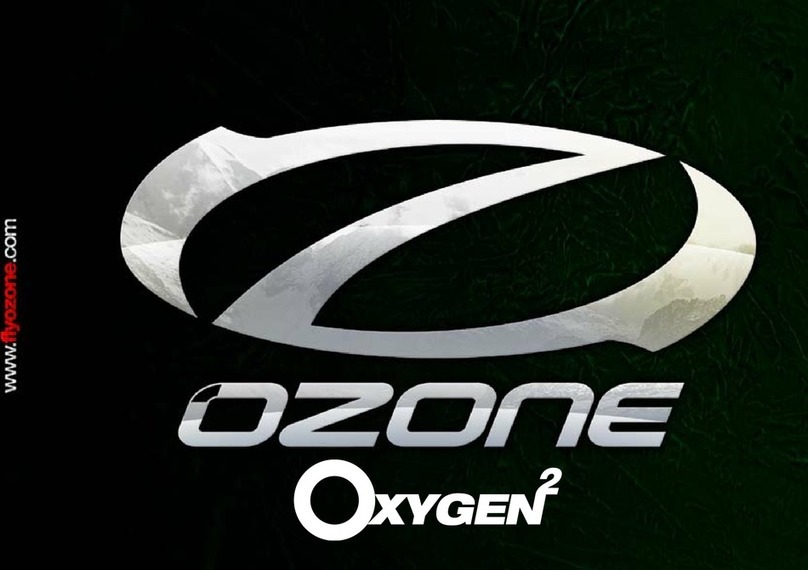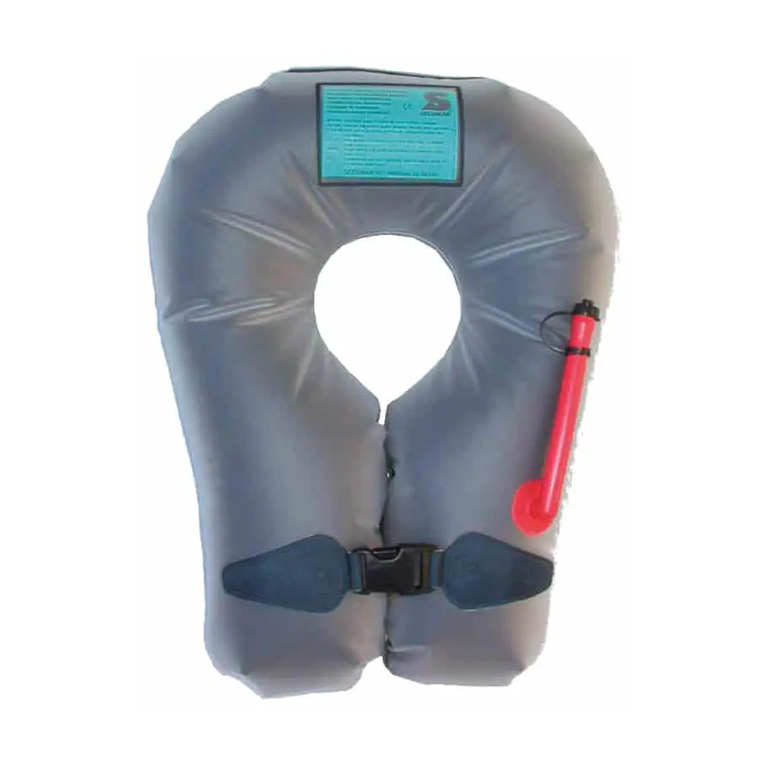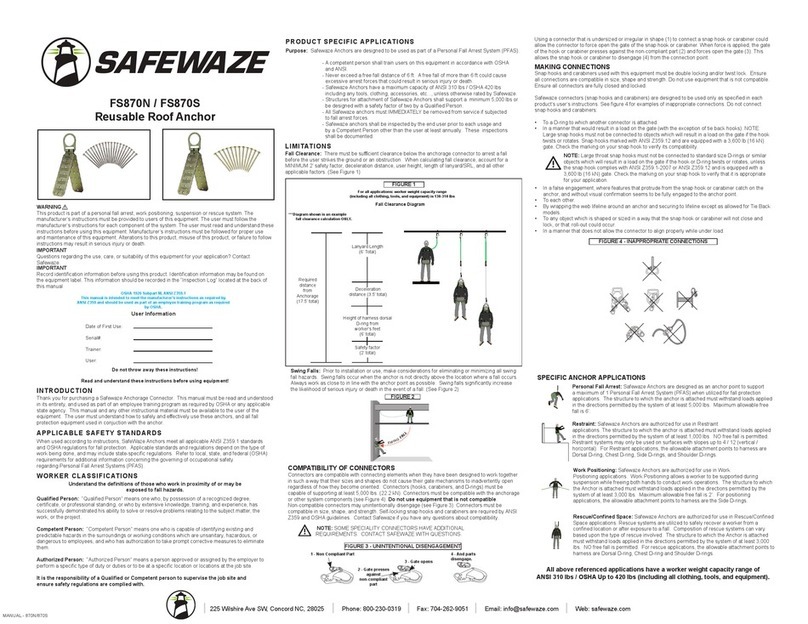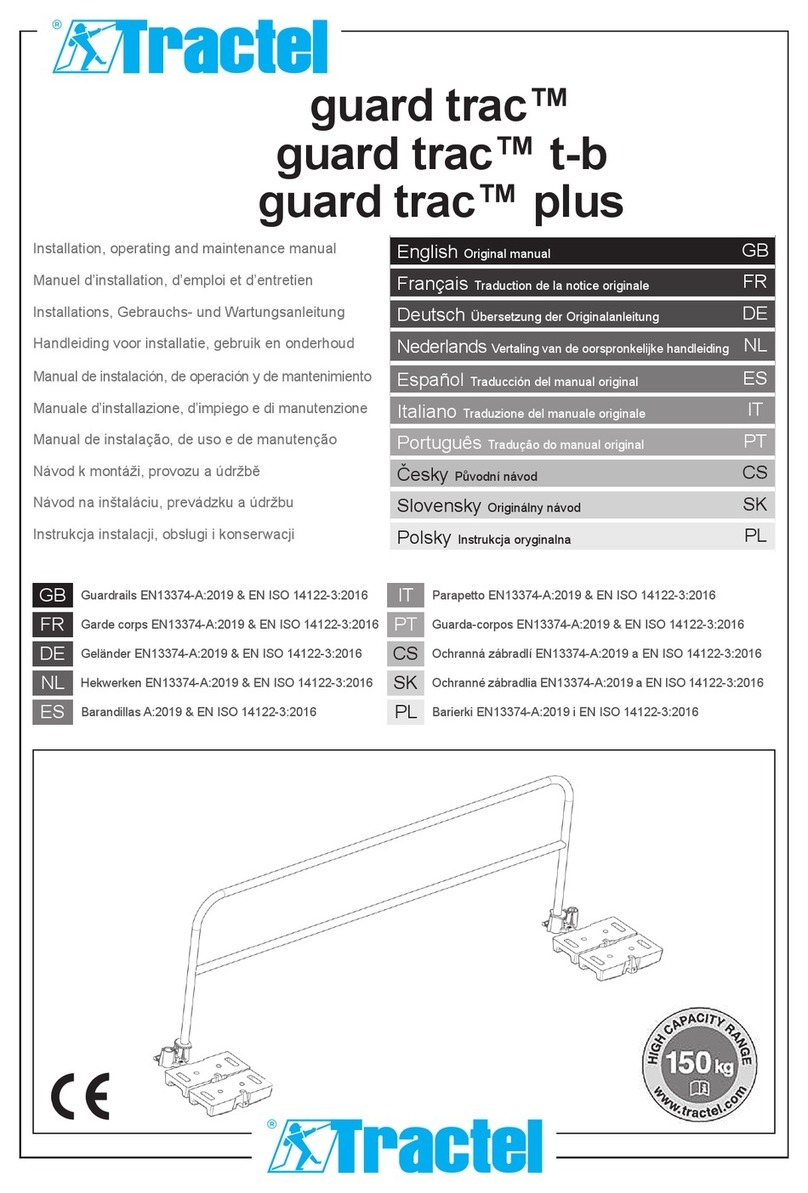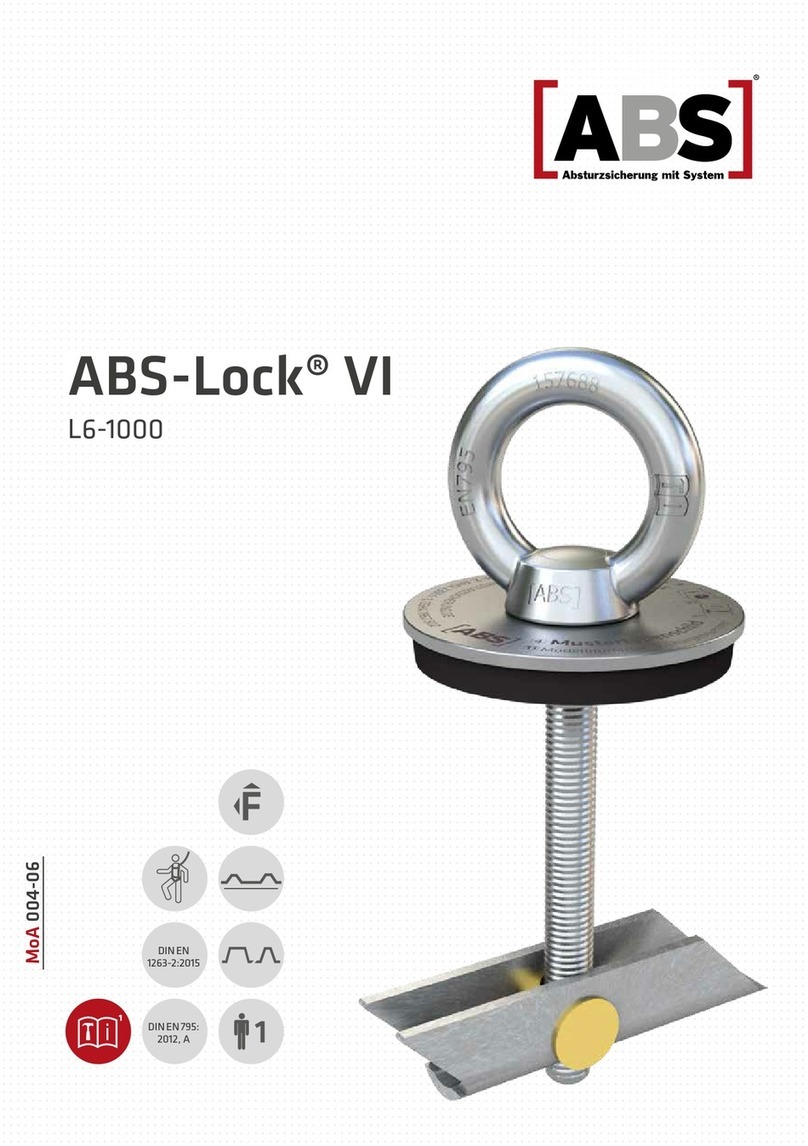
B07905-J 2 EN-260318
5 Assembly and Removal
5.1 Preparations
The mounting location for each lifting point has to ensure that
•the load can take the forces safely to be applied without suffering
deformation,
•the lifting point can be assembled flush,
•no areas of danger are created (crushing point, shearing point),
•transportation is not restrained by overhang,
•incorrect use is avoided,
•the suspension gear cannot be damaged, for example by sharp edges,
•the lifting point can be used easily.
5.2 Assembly
The useful depth of the thread must enable the lifting points to be safely
screwed in. Use only the delivered screws!
Make sure the tapped hole is arranged at right angle to the attachment face on
the component. The depth of the thread „L“ of the component must at least be
as follows:
L = 1,0 x d for steel
L = 1,25 x d for castings
L = 2,0 x d for aluminum
L = 2,5 x d in aluminum-magnesium-alloys
(L = depth of thread; d = thread diameter)
•Make sure the threads of the lifting point and in the
component are clean and dry.
•For lifting points have to remain on the component a usual fluid safety
agent for screws has to be used.
•In case of straight fittings the nut has to be secured against unintentionally
loosening.
•TWN 0123, TWN 1120 and TWN 1830:
Use a suitable open-ended spanner or ring spanner to fix the lifting points
so as to be finger-tight.
Load Table [t]
TWN Article-
no.
WLL
[t]
usable
thread
length
[mm]
Screw datas / suspension link
[mm]
tightening
torque
[Nm]
0° 0° 90° 90° 0°- 45°
45°- 60°
dissym.
3)
0°- 45°
45°- 60°
dissym.
3)
TWN 0121/1
F35000
1,12
M16 x 25
M16 x 40 DIN 7984 8.8 170
1,12 2,24 1,12 2,24 1,6 1,12 1,12 2,4 1,7 1,12
F35010
2,0
M20 x 30
M20 x 50 DIN 7984 8.8 350
2,0 4,0 2,0 4,0 2,8 2,0 2,0 4,2 3,0 2,0
F35020
3,15
M24 x 36
M24 x 60 DIN 7984 8.8 600
3,15 6,3 3,15 6,3 4,5 3,15 3,15 6,7 4,7 3,15
F35030
5,3
M30 x 50
M30 x 80 DIN 6912 10.9 1200
5,3 10,6 5,3 10,6 7,5 5,3 5,3 11,2 8,0 5,3
TWN 0122
F35070
3,15
M16 x 25
M16 x 45 DIN 7984 10.9
170
3,15 6,3 3,15 6,3 4,5 3,15 3,15 6,7 4,7 3,15
F35075
5,3
M20 x 36
M20 x 60 DIN 7984 10.9
350
5,3 10,6 5,3 10,6 7,5 5,3 5,3 11,2 8,0 5,3
F35080
8,0
M30 x 50
M30 x 80 DIN 6912 10.9
950
8,0 16 8,0 16 11,3 8,0 8,0 17 12 8,0
F35095
15 M36 x 53
M36 x 90 DIN 6912 10.9
1900
15 30 15 30 21,2 15 15 31,8 22,5 15
F35098
21,2
M42 x 67
M42 x 100sim.DIN7984 10.9 Sp.
2100
21,2 42,4 21,2 42,4 30 21,2 21,2 45 31,8 21,2
F35101
25 M45 x 67
M45 x 110sim.DIN7984 10.9 Sp.
2400
25 50 25 50 35,4 25 25 53 37,5 25
F35102
31,5
M56 x 88
M56 x 135sim.DIN7984 10.9 Sp.
3200
31,5 63 31,5 63 44,5 31,5 31,5 66,8 47,3 31,5
F35285
36 M56 x 88
M56 x 135sim.DIN7984 10.9 Sp.
3200
36 72 36 72 50,9 36 36 76,4 54 36
TWN 0123
F34110
1,12
M16 x 30
B16 x 70 x 35
hand-
screwed
1,12 2,24 1,12 2,24 1,6 1,12 1,12 2,4 1,7 1,12
F34115
1,12
M16 x 30
A16 x 110 x 60 1,12 2,24 1,12 2,24 1,6 1,12 1,12 2,4 1,7 1,12
F34120
2,0
M20 x 38
B16 x 70 x 35 2,0 4,0 2,0 4,0 2,8 2,0 2,0 4,2 3,0 2,0
F34121
2,0
M20 x 38
A16 x 110 x 60 2,0 4,0 2,0 4,0 2,8 2,0 2,0 4,2 3,0 2,0
F34130
3,15
M24 x 35
B18 x 85 x 40 3,15 6,3 3,15 6,3 4,5 3,15 3,15 6,7 4,7 3,15
F34131
3,15
M24 x 45
A18 x 110 x 60 3,15 6,3 3,15 6,3 4,5 3,15 3,15 6,7 4,7 3,15
TWN 0127
F35157
3,15
M20 x 38
M20 x 50 ISO 4017 10.9
350 3,15 6,3 3,15 6,3 4,5 3,15 3,15 6,7 4,7 3,15
F35158
5,3
M24 x 35
M24 x 50 ISO 4017 10.9
600 5,3 10,6 5,3 10,6 7,5 5,3 5,3 11,2 8,0 5,3
TWN 1120
F34405
0,3
M8 x 18 M8 x 35 12.9
hand-
open-
ended
spanner
0,3 0,6 0,3 0,6 0,42 0,3 0,3 0,64 0,45 0,3
F34390
0,45
M10 x 18
M10 x 35 12.9 0,45 0,9 0,45 0,9 0,64 0,45 0,45 0,95 0,68 0,45
F34395
0,6
M12 x 23
M12 x 40 12.9 0,6 1,2 0,6 1,2 0,85 0,6 0,6 1,3 0,9 0,6
F34400
1,4
M16 x 28
M16 x 45 10.9 2,1 4,2 1,4 2,8 2,0 1,4 1,4 3,0 2,1 1,4
F34410
2,5
M20 x 32
M20 x 50 10.9 3,0 6,0 2,5 5,0 3,5 2,5 2,5 5,3 3,8 2,5
F34420
3,5
M24 x 40
M24 x 60 10.9 6,0 12 3,5 7,0 4,9 3,5 3,5 7,4 5,3 3,5
F34430
6,7
M30 x 52
M30 x 80 12.9 7,1 14,2 6,7 13,4 9,5 6,7 6,7 14,2 10 6,7
F34440
8,0
M36 x 66
M36 x 100 12.9 12,5 25 8,0 16 11,3 8,0 8,0 17 12 8,0
TWN 1830
F34306
0,45
M10 x 15
B13 x 55 x 33
hand-
open-
ended
spanner
0,9 1,8 0,6 1,2 0,85 0,6 0,6
1,3 0,9 0,6
F34307
0,6
M12 x 18
B13 x 55 x 33 1,2 2,4 0,7 1,4 1,0 0,7 0,7
1,5 1,1 0,7
F34300
1,4
M16 x 20
B13 x 55 x 33 2,8 5,6 1,7 3,4 2,4 1,7 1,7
3,6 2,6 1,7
F34310
2,5
M20 x 25
B16 x 70 x 35 5,3 10,6 2,8 5,6 4,0 2,8 2,8
5,9 4,2 2,8
F34320
3,5
M24 x 30
B18 x 85 x 40 7,0 14 4,0 8,0 5,7 4,0 4,0
8,5 6,0 4,0
F34330
5,3
M30 x 40
B22 x 100 x 50 10 20 6,3 12,6 8,9 6,3 6,3
13,4 9,5 6,3
F34340
8,0
M36 x 50
B22 x 100 x 50 15 32 9,5 19 13,4 9,5 9,5
20,2 14,3 9,5
F34350
10 M42 x 60
B32 x 140 x 70 18 36 12,5 25 17,7 12,5 12,5
26,5 18,8 12,5
F34353
12,5
M45 x 65
B32 x 140 x 70 20 40 15 30 21,2 15 15
31,8 22,5 15
F34355
12,5
M48 x 68
B32 x 140 x 70 20 40 16
32
22,6 16 16
33,9 24 16
F34360
17 M56 x 78
B32 x 140 x 70 28 56 22 44 31,1 22 22
46,7 33 22
F34363
17 M64 x 96
B32 x 140 x 70 28 56 22 44 31,1 22 22
46,7 33 22
TWN 1890
F35243
0,63
M10 x 17
M10 x 45 ISO 4017 12.9 80 0,63 1,26 0,63 1,26 0,89 0,63 0,63 1,3 0,95 0,63
F35244
1,0
M12 x 22
M12 x 50 ISO 4017 12.9 130 1,0 2,0 1,0 2,0 1,4 1,0 1,0 2,1 1,5 1,0
F35245
1,7
M16 x 30
M16 x 70 ISO 4017 10.9 180 1,7 3,4 1,7 3,4 2,4 1,7 1,7 3,6 2,6 1,7
F35246
2,5
M20 x 38
M20 x 80 ISO 4017 10.9 350 2,5 5,0 2,5 5,0 3,5 2,5 2,5 5,3 3,8 2,5
F35247
4,0
M24 x 40
M24 x 90 ISO 4017 12.9 500 4,0 8,0 4,0 8,0 5,7 4,0 4,0 8,5 6,0 4,0
F35249
6,0
M30 x 44
M30 x 100 ISO 4017 10.9 500 6,0 12 6,0 12 8,5 6,0 6,0 12,7 9,0 6,0
F35250
8,0
M36 x 64
M36 x 120 ISO 4017 12.9 750 8,0 16 8,0 16 11,3 8,0 8,0 17 12 8,0
F35251
10 M42 x 74
M42 x 140 ISO 4017 10.9 950 10 20 10 20 14,1 10 10 21,2 15 10
1) For tapped holes in steel 2) Additional technical THIELE-specification must be observed. 3) Reduced WLL according to DIN 685-5.




